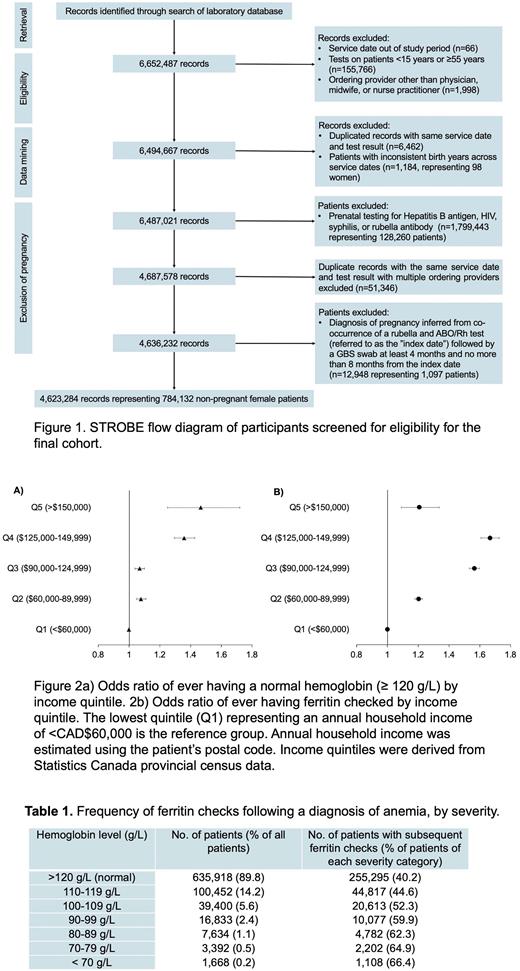Abstract
BACKGROUND Iron deficiency anemia (IDA) is one of the most prevalent medical conditions in the world. Iron deficiency (ID) and IDA are common among females of reproductive age, with health consequences both during and outside of pregnancy. However, screening for ID and IDA is variable, and often screening is performed with a complete blood count (CBC) alone, which is neither sensitive nor specific for IDA, in contrast to ferritin.
OBJECTIVES The primary objective was to determine the prevalence of screening for ID and IDA over a 3-year period in non-pregnant females of reproductive age who had tests performed at outpatient laboratories in Ontario, Canada. Secondary objectives were to determine the prevalence and severity of ID and IDA, and to identify demographic and provider characteristics that influence the likelihood of screening.
METHODS This was a retrospective cohort study of non-pregnant females ages 15-54 in Ontario, Canada. Laboratory data was provided by Dynacare, the second-largest laboratory company in the province, performing around 30% of annual non-hospital outpatient laboratory testing. Tests between January 2017 and December 2019 were retrieved. Tests ordered by providers other than physicians, midwives, or nurse practitioners were excluded. As this was a study of non-pregnant patients, records from patients who had a beta-hCG test of 5 IU or greater, explicitly defined antenatal laboratory testing, or who fulfilled criteria of a previously published laboratory definition of pregnancy were excluded. ID was defined as ferritin < 30 µg/L and severe ID ferritin < 15 µg/L. Anemia was defined as hemoglobin < 120 g/L, and IDA defined as a ferritin < 30 µg/L and hemoglobin < 120 g/L measured within 90 days of each other. Annual household income was estimated using the patient's postal code and Statistics Canada census data. Research ethics board approval was obtained. Dynacare was not involved in study design or analysis.
RESULTS 6,652,487 records were retrieved from the Dynacare database. 4,623,284 records representing 784,132 non-pregnant females were eligible for inclusion (Figure 1). Of this cohort, 644,066 patients (82.1%) had a ferritin checked at least once during the study period, with a mean ferritin of 60.7 µg/L (SD 86.9 µg/L). 245,953 (38.3%) were iron deficient with a < 30 µg/L at least once, with 14.4% of patients having severe ID with ferritin < 15 µg/L. Family physicians or general practitioners ordered most ferritin tests (74.1%). 709,434 patients (90.5%) had a CBC checked at least once, with a mean hemoglobin of 130.1 g/L (SD 12.9 g/L). Of those who had a CBC checked, 134,265 (19%) had anemia (hemoglobin < 120 g/L) at least once. 633,396 patients (80.8%) were screened for and 82,655 (13.1%) had IDA. The proportion of ferritin testing increased with increasing anemia severity (Table 1), ranging from 40.2% of patients with normal hemoglobin levels having a ferritin test, to 66.4% of patients with hemoglobin < 70 g/L having a ferritin checked. Median annual household income was CAD$89,387.80 (IQR 69178.8, 107037.5) at the first service date. Compared to patients in the lowest household income quintile (Q1, <CAD$60,000 per year), the odds of ever having a normal hemoglobin generally increased with increasing income quintiles, with odds ratio (OR) 1.08 (95% CI 1.05-1.11), 1.07 (95% CI 1.04-1.10), 1.36 (95% CI 1.30-1.43), and 1.47 (95% CI 1.25-1.72) for Q2-5 respectively. Compared to patients in Q1, the odds of having a ferritin checked was also greater with higher income quintiles with OR for Q2-5 1.20 (95% CI 1.18-1.23), 1.56 (95% CI 1.53-1.60), 1.67 (95% CI 1.61-1.73), and 1.21 (95% CI 1.09-1.34) respectively (Figure 2).
CONCLUSION: This was a large study of non-pregnant females of reproductive age in Ontario, Canada, a high-income province within a publicly funded health services system. Our cohort had a high median household income ($89,387.80, compared to a province-wide median of $65,285 in 2016). A large proportion of patients were screened for ID - yet even in this relatively privileged population, ID affected nearly 40% and IDA 13% of those screened. Screening for ID was more likely with increasing anemia severity. Despite low household income being associated with the greatest odds of anemia, low income was associated with lower odds of having a ferritin check. These findings highlight socioeconomic disparities in screening and inequitable diagnosis of ID and IDA in this population.
Disclosures
Auerbach:COVIS Pharma: Other: Data Management, Research Funding; Pfizer: Other: Educational non-promotional presentations; Pharmacosmos: Other: Educational non-promotional presentations. Sholzberg:Octapharma: Research Funding.
Author notes
Asterisk with author names denotes non-ASH members.


This feature is available to Subscribers Only
Sign In or Create an Account Close Modal